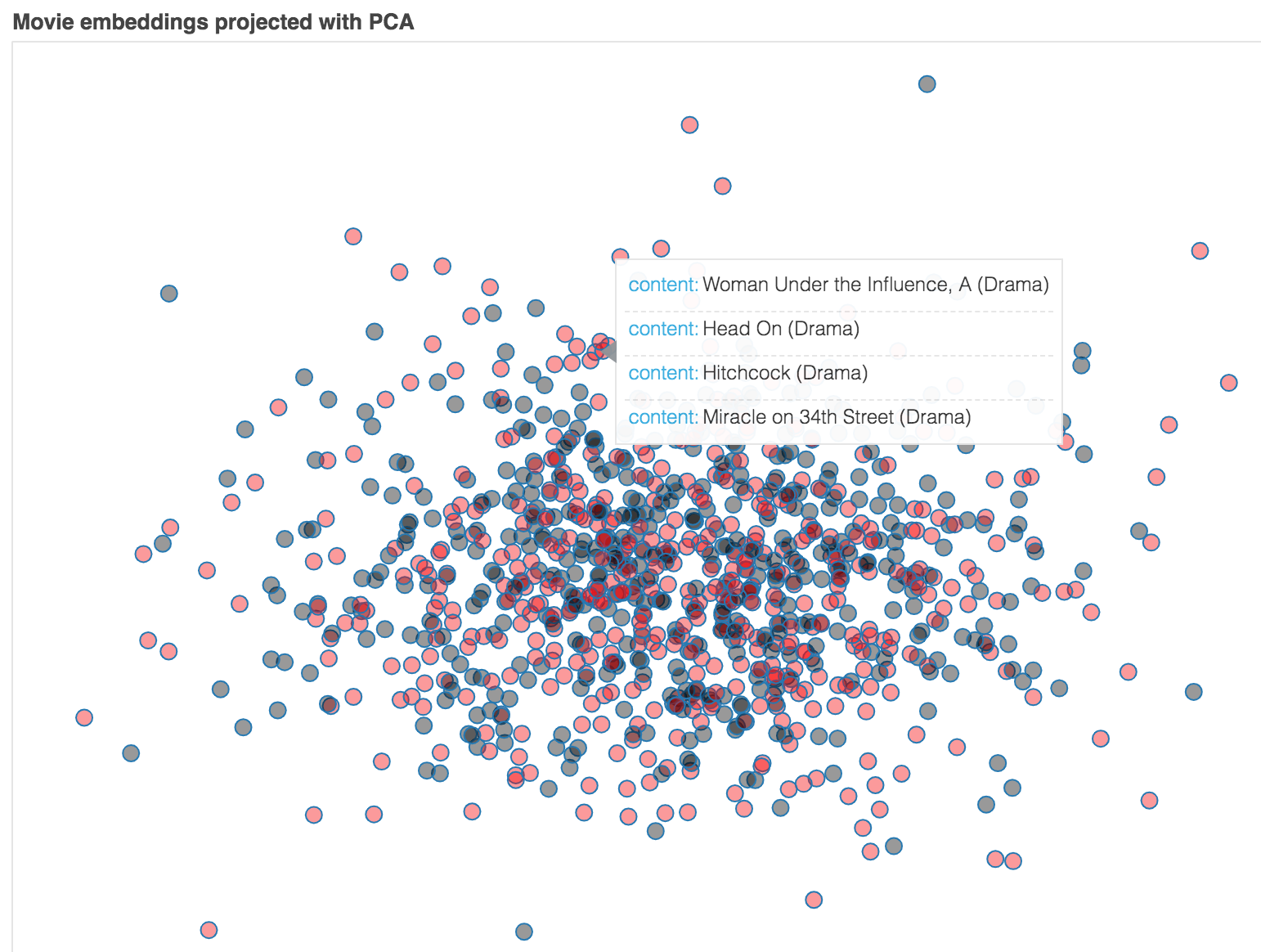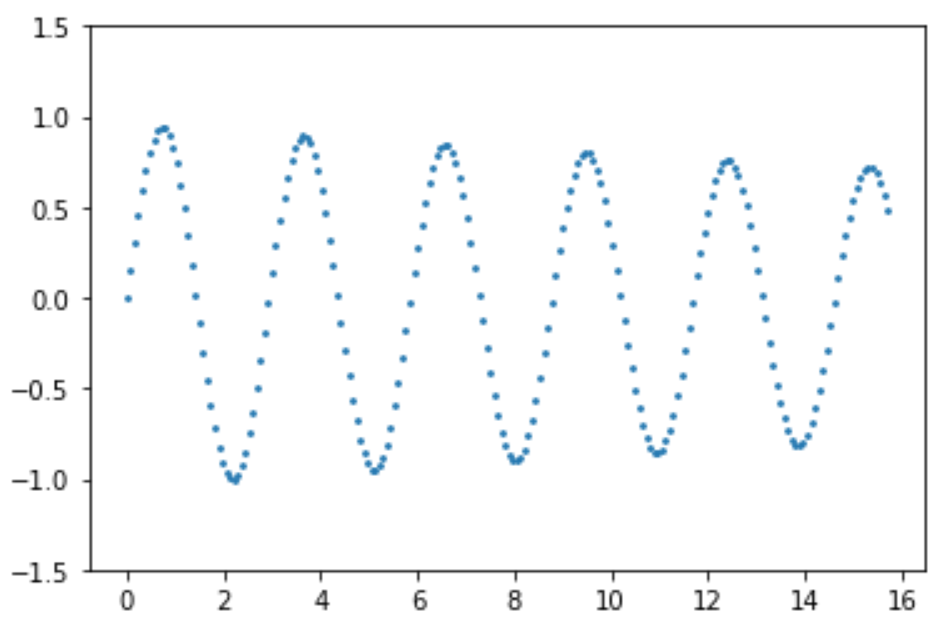This repository is just a collection of notebooks that I'm using to explore various deep learning (DL) concepts and APIs (such as keras). The mathematics behind the networks is straightforward but tedious so I'm focusing on applying networks.
Previously I tried DL for regression on some tabular data, but it struggles to keep up with the simple random forest. DL shines with unstructured data so I turned to the standard hello world of MNIST classification:
The next step is to play around with tokenizing text and representing words and documents with sparse work vectors:
Before jumping into dense word vectors, I wanted to explore the whole embedding mechanism using some simple categorical variables. Before using the built-in embedding layer with keras, I wanted to build some examples manually.
-
Manual movie embeddings via movie+user->rating (Got ok but not great results here.)
-
Separate layers for movie and user IDs joined into a DL pipeline (Got good results here.)
-
Keras embeddings via movie+user->rating (slightly older than the previous two now.)
PyTorch seems a bit more low-level but it's very cool and easy to use. It is essentially a numpy with automatic differentiation package, but also includes a torch.nn layer that looks very much like Keras. First, I went through some exercises following their tutorial to get use to the library and how to use the auto differentiation:
Now, I've had some very good luck building my own collaborative filtering mechanism using my own gradient descent with momentum in raw pytorch. I am more or less able to get the same predictive ability using matrix factorization that I did with the deep learning version above. Implemented gradient descent with momentum and then full AdaGrad. Didn't do any minibatching.
- Collaborative filtering with pytorch (Cool. learned to display interactive graphs with bokeh too!)
I'm going to start again on collaborative filtering with pytorch: Regularized collaborative filtering with pytorch. Lessons:
- I was only tracking the training error, which I could get pretty low but then I was wondering why the validation error using a random forest OOB (user+movie->rating) often was not good. Duh. I'm watching the training error inside the training loop, not the validation error.
- Ollie just said: "...it depends on what you are looking for. Embeddings as first step or embeddings or a means of reducing dimensions. First one is validation, second is training error and even not using any validation or test at all."
- By randomly selecting validation and training sets at each iteration (epoch), we are moving to stochastic gradient descent (SGD). Previously I only used gradient descent.
- I could not get the bias version working well. Yannet pointed out that I need to initialize my randomized weights so that the predicted rating has an average of 2.5 or somewhere else between zero and five. Initialization does after all seem to make a difference, in both training and validation error.
- Adding bias dramatically slowed the training process down! Way more than I would expect, given the small increase in data and operations.
- I also noticed that Jeremy/Sylvain does L2 regularization in their book, which clued me in to the fact that validation error is important. We don't want those coefficients getting too big as they are likely chasing something in the training set.
- I also found that simple gradient descent with momentum did a pretty good job and I didn't need the complexity of AdaGrad.
- Another trick from fastai book is to keep the predicted rating in the range 0..5, which constrains where the loss function can send gradient descent.
Dang. I still don't think I'm getting a good result and it is likely my simple gradient descent mechanism. I'm going to try this over again using the built-in pytorch optimizers. Ha. was most likely incorrect assessment and display issues with indexing. All is well now:
I'm going to try working through the keras book examples using pytorch:
oooook. It turns out I was using just 1000 training and 1000 testing records but Keras was using a much bigger data set with 25,000 records each. I can then using my PyTorch methods get roughly the same 75% accuracy from the Keras book. I redid everything in this notebook:
- Playing with linear algebra for neural nets Just playing with matrix dimensions so far
- Numpy only for forward step of RNN
- RNN using tensors not neuron layers; predicts sin(y):
- RNN for last name -> language classification Three ways: record-by-record, all records' jth char vec at once using raw matrices, again using torch.nn layers.
- LSTM for last name -> language classification (using torch nn layers)
- Same LSTM using Keras
- Playing with fastai sample data
- Try to generate Federalist papers like text
- Keras: LSTM for last name -> language classification
- LSTM for last name -> language classification
Ok, starting again using simple RNN using matrix alg from my article.
- Generate lastnames for specific language
- Generate obama speeches This works but the hidden state is reset at the start of every small chunk in order to get truncated back propagation.
- Generate obama speeches, truncated backpropagation This version attempts to divide up the entire text into chunks and then use a single batch containing all chunks. Then inside the training loop I can occasionally wipe out the gradient but keep the hidden state accumulating.
- Generate obama speeches, add embedding layer Adding embedding of chars before RNN helps. make len(vocab)->small embedding like 20 squeezes into more meaningful embedding than one of size len(vocab). Fix
sample()so that it doesn't reprocess the entire growing string each time. It's now linear. - Generate obama speeches using 2 stacked RNNs. REALLY hard to train. had to play with weight initialization a lot and learning rate. Only got it to 49% accurate on 1M text size. Tried using
handofrom RNN 1 as input to RNN 2. This was done with chunks. - Generate obama speeches using 2 stacked RNNs but non-chunked Slow but easier to understand since
his just a vector not a matrix. - GRU: Generate obama speeches Use GRU with much deeper bptt than 8 chars. Oh and get non-quadratic
sample()function. Uses nucleus sampling also. Maybe beam search too. nah. no beam search.
- RNN human numbers to integer value classifier Classifier to 1, 2, 3, ... Data is the human numbers set from fastai book chap 12. A warm up for vectorized encoder.
- Record-by-record RNN Encoder-decoder An RNN computes
hcontext vector for input and then we use that context + RNN to generate tokens from output sequence. Convert 'twenty one' to '21', etc... - Vectorized RNN Encoder-decoder Vectorize the encoder-decoder from previous notebook
- RNN/GRU encoder-decoder for French->English Improved the RNN/GRU/Linear objects. Will try some kind of attention.
- Refactored RNN human numbers to integer value classifier Having trouble getting Fr->En working so go back to human numbers with same code.
- Vectorized RNN/GRU encoder-decoder for French->English Vectorized to do batch of phrases at once.
- Vectorized RNN/GRU encoder-decoder for French->English Add attention to translation. I left off here. Attention with non-contextualized GRU seems to work as well or better than simple GRU with context for decoder.
Some notes beyond what is in the notebooks
- the role of a neuron or layer is fluid. the output of a layer could be the probability of class k but, if we add a further layer, it could become a feature that helps the new layer predict features.
- relu for RNN also works, not just tanh for obama speeches. use 0 bias, identity for W. clip gradient values to 1.0. Must use
F.cross_entropy()which combines softmax with that. much better numerical characteristics. Otherwise get NaN immediately. Clipping isn't required it seems but improves convergence. Seems to tolerate higher learning rate. Can't see to get relu version to match final accuracy score of tanh. Actually at epoch 20, tanh gets 55% and relu gets 63% (same 0.001 learning rate and relu clipped grad values at 10). Hmm...i have logs of some tanh runs though that are 64% at epoch 20. damn hyperparameters. - Training is super sensitive to weight initialization. Using sd=0.001 training didn't move. With 1.0 it is too far away sometimes from final weights. Couldn't figure out why my stacked RNN wasn't training. sd=0.001 seems too low. Well, if you run multiple times with sd=0.001 sometimes it works. frustrating to train these beasts. Even more complicated. Seems to eventually start to convert/train after maybe 10 trivial/no movements.
- A general principle for autograd with pytorch: you can’t reuse partial results from one optimization step to the next, despite that being OK if we were doing symbolic derivatives. It’s just a limitation of how dynamic auto gradients are computed. E.g., I wanted to use a single output vector (the last
h) from the encoder in the multiple steps of the decoder but got the dreadedTrying to backward through the graph a second time, but the buffers have already been freed.Each decoder step is a function of that previous single encoderhand pytorch can only compute the derivative through a series of operations once. Triedloss.backward(retain_graph=True)w/o success too. - another weird detail. h in RNN becomes H matrix for batches, one h vector per record of batch. Now, if we add a bias term, we also need bias per record so B matrix not vector. Now, when using (not training) decoder to generate result, we are doing one record so we need one bias. which bias? hahah. I’ve just been doing
B[:,0]picking one. is that right? i.e., we’ve trainedbatch_sizebias vectors but use only one during generation. which bias do we use?! Ah. just use bias vector and broadcasting does the rest. so it's b not B. - Weight matrix initialization matters a huge amount. I was trying to do concatenation of a context vector with an input vector for a decoder but it was not training well at all. When I use a separate matrix to bring in the context in the decoder, I was initializing Matt to the identity matrix so that it brought context in unaltered. However, when concatenating I was using a random matrix for the combined input and context vectors. This got noticeably worse performance. Presumably in the end this would train just as well but it is much slower at the very least. Perhaps it wouldn't even find the right spot with gradient descent. Wow. even the stddev matters for randn matrics. If too tight, doesn't train in some cases. Might also be reverse!
- Dropout is like bootstrapping for RFs or maybe selecting just a subset of m variables during splitting. Goal is to create multiple independent estimators.

